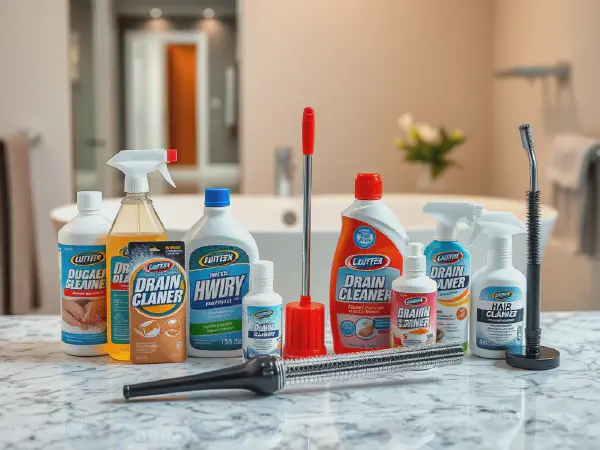Best Drain Cleaners for Hair: Top Products & How to Unclog Drains

Best Drain Cleaners for Hair: Your Ultimate Guide to Clog-Free Drains
Dealing with a clogged drain due to hair can be incredibly frustrating. This comprehensive guide explores the best drain cleaners available, providing expert advice on selecting the right product, using it safely, and preventing future hair-related blockages. Say goodbye to standing water and hello to smooth-flowing drains!
Understanding Hair Clogs and Why You Need a Good Drain Cleaner
Hair is a major culprit behind clogged drains in bathrooms and showers. It combines with soap scum, grease, and other debris to form stubborn blockages. Using the right drain cleaner is essential to effectively dissolve these clogs and restore proper drainage.
Top Drain Cleaners for Hair: Our Expert Picks
Choosing the best drain cleaner can be overwhelming. We've researched and tested a variety of products to bring you the top-rated drain cleaners for hair, based on effectiveness, safety, and user reviews. (Note: Always follow the manufacturer's instructions and safety precautions.)
-
Chemical Drain Cleaners: These are typically the most powerful options for dissolving hair. Brands like Drano Max Gel Clog Remover are popular for a reason. They contain strong chemicals, like sodium hydroxide, to break down hair and other organic matter.
Pros: Fast-acting, highly effective for tough clogs.
Cons: Can be corrosive and require careful handling. -
Enzyme Drain Cleaners: For a more eco-friendly and safer alternative, consider enzyme drain cleaners. These products use natural enzymes to digest hair and other debris, gradually clearing the drain.
Pros: Environmentally friendly, safer for pipes and the user.
Cons: May take longer to work compared to chemical cleaners. -
Manual Drain Cleaners: For stubborn clogs, manual drain cleaners like drain snakes or augers offer a physical solution.
Pros: Safe and effective for all types of pipes.
Cons: Requires some physical effort to operate.
How to Choose the Best Drain Cleaner for Shower Hair
Selecting the right drain cleaner depends on several factors:
- Clog Severity: For minor clogs, enzyme cleaners might suffice. For tougher blockages, you may need a chemical cleaner.
- Pipe Material: Some cleaners can damage older or delicate pipes. Check the product label for compatibility with your plumbing.
- User Reviews: Read reviews to understand how effective a cleaner is for hair clogs and its overall performance.
Step-by-Step Guide: How to Use Drain Cleaner for Hair Clogs
Follow these steps to safely and effectively unclog your drain:
- Preparation: Put on gloves and eye protection. Ensure good ventilation.
- Pour the Cleaner: Carefully pour the recommended amount of the drain cleaner into the drain.
- Wait: Allow the cleaner to sit for the time specified on the product label (usually 15-30 minutes).
- Flush: Flush the drain thoroughly with hot (not boiling) water.
- Repeat if Necessary: If the clog persists, repeat the process. If the clog remains stubborn, consider using a drain snake or calling a plumber.
Key Ingredients and Their Role in Drain Cleaners
Understanding the ingredients can help you make a more informed choice:
- Sodium Hydroxide (Lye): A strong chemical that dissolves hair and grease. Use with extreme caution.
- Sulfuric Acid: Another powerful chemical effective at dissolving clogs. Handle with extreme care and use proper ventilation.
- Enzymes: Natural enzymes break down organic matter like hair. A safer and more eco-friendly option.
- Biodegradable Formulas: These formulas are designed to be less harmful to the environment while still being effective.
Safety Precautions When Using Drain Cleaners
- Wear Protective Gear: Always wear gloves and eye protection.
- Avoid Mixing Chemicals: Never mix different drain cleaners, as this can create dangerous reactions.
- Follow Instructions: Read and follow the product instructions carefully.
- Ventilation: Ensure the area is well-ventilated to prevent the buildup of fumes.
- Keep Out of Reach: Store drain cleaners in a safe place, away from children and pets.
DIY Drain Cleaning Methods
Before resorting to chemical drain cleaners, try these DIY methods:
- Boiling Water: Pour boiling water down the drain (avoid this with PVC pipes).
- Baking Soda and Vinegar: Pour 1 cup of baking soda followed by 1 cup of vinegar, let it fizz, and flush with hot water after 30 minutes.
- Plumbing Snake (Drain Snake/Auger): Use a plumbing snake to physically remove the clog.
- Wire Hanger: Straighten a wire hanger and bend one end into a small hook to try to pull out the hair.
Preventing Hair Clogs: Proactive Tips
Preventative measures can save you time and money:
- Use Drain Strainers: Install drain strainers in showers and tubs to catch hair.
- Regular Cleaning: Clean hair traps and strainers regularly.
- Avoid Flushing Hair: Dispose of hair in the trash.
- Trim Hair Before Showering: This minimizes the amount of hair that goes down the drain.
Frequently Asked Questions (FAQ)
What is the best drain cleaner for hair clogs?
The best drain cleaner depends on the severity of the clog and your preference for safety and environmental impact. Chemical drain cleaners are often the most effective for tough clogs, but enzyme cleaners provide a safer alternative for regular maintenance.
Are chemical drain cleaners safe for all types of pipes?
No, chemical drain cleaners can damage older or delicate pipes. Always check the product label for compatibility with your plumbing system.
How often should I use drain cleaner?
For preventative maintenance, use an enzyme drain cleaner once a month. Chemical cleaners should only be used when a clog occurs.
